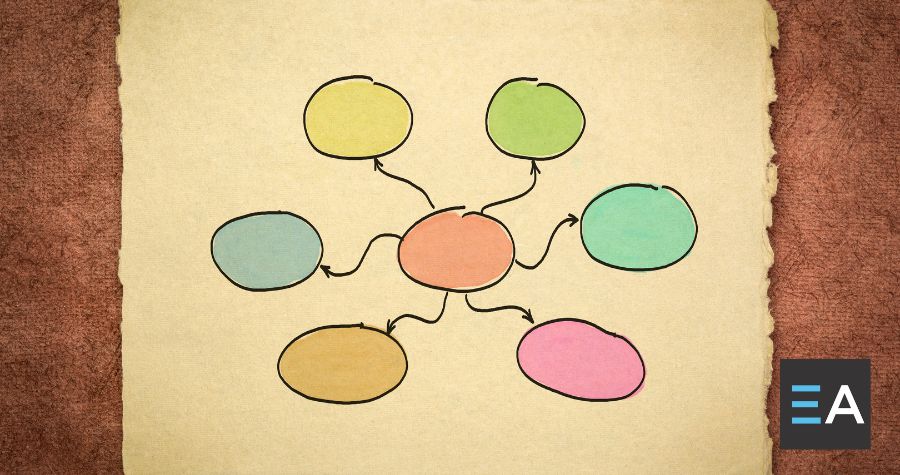
Best Fonts for Books: Layout, Size, Spacing, and More
May 18, 2023
How to Quote Song Lyrics in Your Story
May 22, 2023Use the Mind Mapping Method for Your Book Ideas
Content marketers and writers looking for an effective way to come up with new book ideas can find success in the mind mapping method. This multipurpose brainstorming process allows marketers and writers alike to turn their initial concepts into full-fledged, carefully thought out stories without wasting too much time or mental energy. Let’s explore how this technique can help revolutionize your workflow so that you’re confidently able to tackle whatever project comes your way!
Introducing mind maps during brainstorming paints a bigger picture
When it comes to generating book ideas, traditional brainstorming methods can be limiting. That’s where mind mapping comes in. Mind mapping is a form of visual thinking that allows you to map out ideas and connections in a nonlinear way. By organizing your thoughts in a visual format, you can more easily see patterns, make connections, and generate new ideas. This makes mind mapping an excellent tool for problem solving and idea generation, especially when it comes to book writing. So next time you’re feeling stuck on a book idea, try mind mapping and see where your visual thinking takes you.
Creating an effective mind map starts with a central idea
Have you ever found yourself struggling to study for a test or remember important information? One strategy that can greatly enhance your memory and creative thinking skills is creating a mind map. To create an effective mind map, start by selecting a central idea or topic and drawing a circle around it. Then branch out with subtopics or related ideas and connect them to the central idea with lines or arrows. Use keywords, images, and colors to help make the mind map visually appealing and memorable. Remember to always review your mind map and continue to add new information as needed.
Mind mapping digitally is more practical than a pen-and-paper strategy
The advantages of using a digital platform over paper-based methods in today’s world are numerous. One advantage is the ability to easily search and categorize information, which saves time and resources. With digital platforms, there is no need to worry about losing important documents as everything can be stored in a secure and organized manner. Additionally, digital technology can aid in memory, idea generation, and decision making through the use of features such as reminders, brainstorming tools, and analytics.
Applying your mind map can help develop plot lines and characters
As a writer, using mind maps to develop your plot lines and characters can be invaluable. Not only does it encourage creative thinking, but it also helps with time management and idea generation. By putting your ideas on paper in a visual format, you can easily see how they connect and flow together. This not only assists with developing your plot but can also reveal new aspects of your characters. To create a successful mind map, start with a central idea and branch out from there, adding details and subplots. This process not only helps with organizing your thoughts but also allows for a more organic and dynamic development of your story and characters. So next time you’re stuck on a plot line or character development, try using a mind map and see where it takes you.
Harnessing the power of a mind map is nothing new
Creative thinking has led many authors to craft their stories in unique and unconventional ways. One famous example is Mark Danielewski’s House of Leaves, a labyrinthine novel that features multiple narratives, footnotes, and textual formatting that mimics the experience of exploring a haunted house. Another is David Mitchell’s Cloud Atlas, which weaves together six different stories across time and space, each with its own distinct voice and genre. Both of these books showcase the power of creative thinking to push the boundaries of traditional storytelling and create truly immersive reading experiences.
Refining the central idea may mean gathering additional research and input from others
Creating a solid idea takes time-management, problem-solving, and decision-making skills. It’s essential to invest time and energy into further refining your idea. Dive deeper into your idea by conducting market research, analyzing data, and examining case studies to gain insight into what has worked and what has not. Seeking input from others is also valuable in refining your idea. Reach out to peers in your industry, mentors, and those with expertise in related fields. These individuals can offer a fresh perspective and constructive feedback that will help you hone your idea and make it stronger. Involving others in the process can also help you identify potential obstacles or opportunities that you may have overlooked.
Mind mapping is an undeniably effective and worthwhile way to structure book ideas. By reflecting upon each idea from all angles, you can expand upon and narrow down your storyboard until it becomes what you want—a solid outline of your story with rich characters, plot lines from A-Z, and various elements to further refine the work. No matter if you choose a paper-based or digital format for mind mapping, writing books through this method will help bring your vision to life in ways you never thought possible. So don’t forget—if you have an idea for a great novel floating around in your head, give mind mapping a try to get it out on the page!



